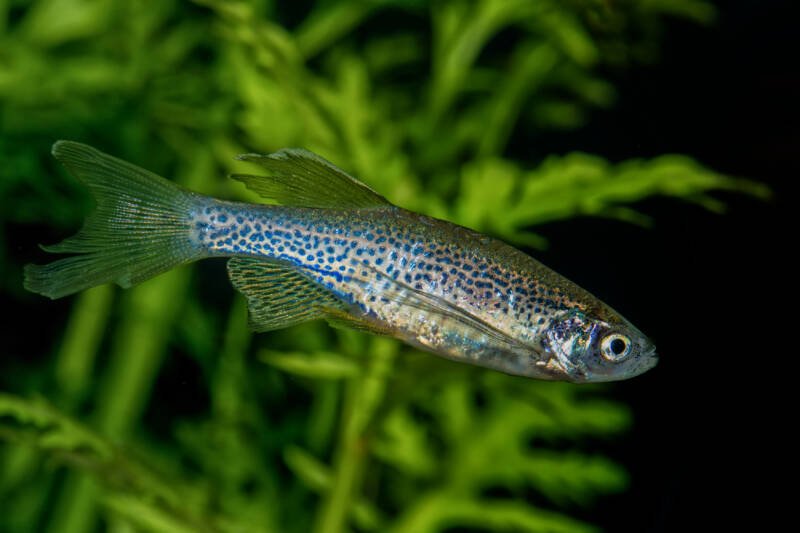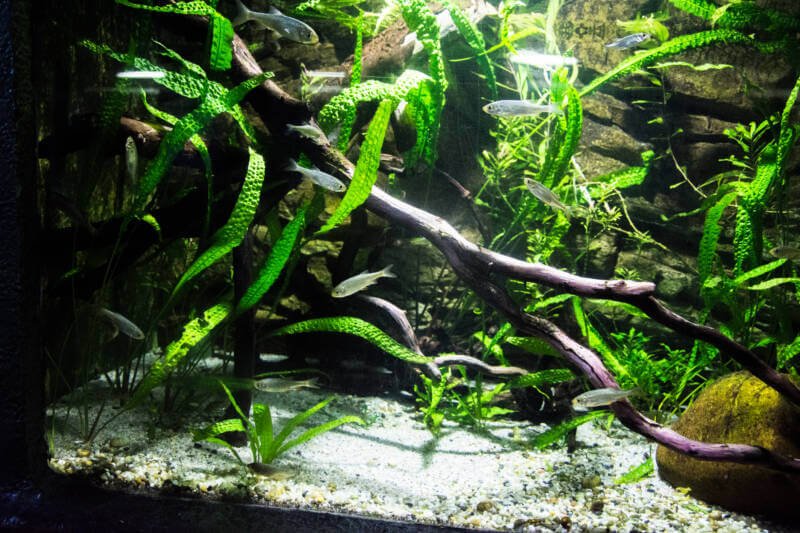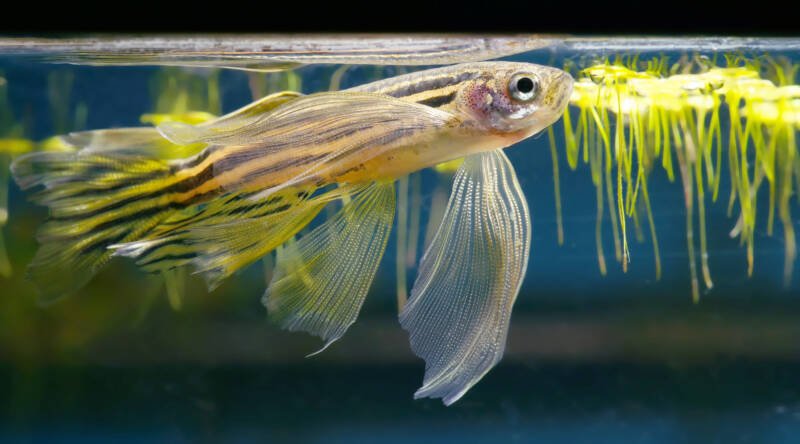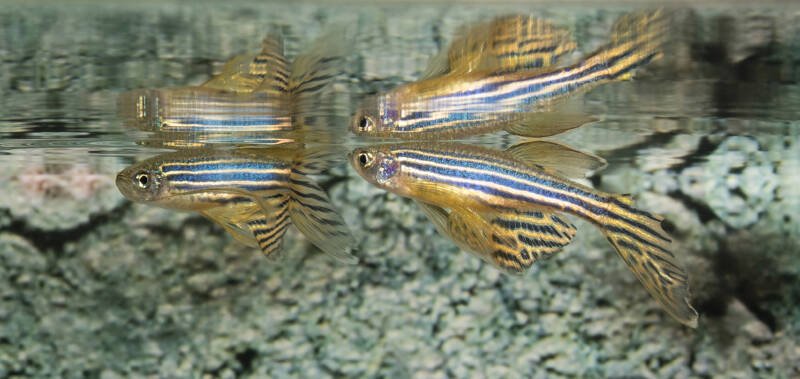Zebra danios (Danio rerio) make for popular tank additions from the Cyprinidae family.

Their distinctive horizontal stripes stand out against plants and other colorful freshwater fish.
And with a hardy nature, they’re the perfect fish for every level of the aquarist.
Zebras have slim, torpedo-like profiles. You can choose from the typical silver background or other available varieties.
Less common options include albinos, a golden background, veil-tails, fantails, and long-finned zebra danios.
Even more popular are leopard danios. Once considered a separate species, new research has found these little fish with sprinklings of dark spots are a variation of zebra danio.

So if you want a more exotic look for your tank, you can mix stripes and spots.
At a Glance
| Minimum tank size: | 10 gal (38 l) |
| School size: | at least five |
| Temperature: | 64-77°F (18-25°C) |
| Lifespan: | 3.5-5.5 years |
| Size: | 2 inches (5 cm) |
| pH: | 6.5-7.0 |
| Hardness: | 5-12 dH |
| Ammonia: | 0 ppm |
| Nitrite: | 0 ppm |
| Nitrate: | < 50 ppm |
In this article
In the Wild
Zebra danios, or zebrafish, inhabit tropical and subtropical Bangladesh, Bhutan, and India.
A similar species once had its range extend to Myanmar and Pakistan, but reclassification narrowed that range.
Zebras prefer slower waters, but the preference ends there. They’ll gravitate anywhere from rice paddies to oxbows to floodplains.
So long as there’s a dark, silty bottom, plenty of plant life on the verge, and a few rocks, they’re happy.
Unhappily, wild zebrafish have suffered habitat loss. This has led to even narrower ranges than after the reclassification of the two species.
Good thing they’re so easy to breed in captivity, though captive-bred zebras aren’t as sturdy as their wild counterparts.
Little Dither Fish
When kept in aquariums, zebra danios reach an adult length of 2 inches or 5 cm.
You CAN keep them in outdoor ponds, and they’ll grow even longer. The added space gives them room to stretch their fins.
Lifespan

As you might expect for freshwater fish on the smaller side, zebrafish only survive for an average of 4 years.
If you stay on top of your water changes, provide high-quality food sources, and maintain a healthy school, you might eke out 5.5 years.
Behavior
Zebra danios MUST stay in a school if you want to keep them healthy. If kept alone, they’ll become stressed and opt to hide out in the tank décor.
Stressed fish tend to fall ill more frequently and faster than calm fish, so skip lone zebrafish.
A minimum school size of five works best. If you go lower, your zebras may develop behavioral problems, such as fin-nipping.
A balanced shoal allows a natural hierarchy to mature. This pecking order keeps the structure in place and curbs unwanted behaviors.
When your zebrafish stay happy and active, they act as dither fish within your tank. Their regular swimming reassures nervous fish – such as Jack Dempseys – that everything’s okay.
This should encourage you to keep a healthy school at all times.
Tank Setup

On average, each zebra danio needs 2 gallons (8 l) of tank space. So a proper school needs a 10-gallon (40 l) tank.
As you scale up your shoal, increase your tank size appropriately. While on the small side, these striped fish need lots of swimming room.
Wild zebrafish come from tropical and subtropical regions. However, zebra danios tolerate a wide range of water temperatures – even allowing you to keep them in outdoor ponds.
So while they may not need a heater, consider the other fish in the tank and their needs.
For outdoor ponds, consider using a de-icer or a pond heater.
Water Conditions
That said, a good water temperature range of 64-77°F or 18-25°C fits the bill.
Zebra danios have SOME cold-water resistance, but exposure to prolonged cold sets them up for illness.
Look at your community as a whole, and aim for the median that suits everyone.
As zebrafish come from captive-bred farms, they aim to match the most common tank conditions.
You need a neutral pH value between 6.5-7.0 and slightly soft waters. If you keep your water hardness between 5-12 dH, your fish should do fine.
Decorating the Zebra Danio Tank

As dither fish, zebra danios prioritize swimming room. They utilize the middle and top water column, though you may catch them swooping down to the bottom if something strikes their fancy.
Darker colored substrates help those stripes stand out. A few river rocks and some pieces of bogwood give your zebras places to play.
You don’t want to clutter the tank, though. A few decorations here and there are plenty.
Zebrafish fall into the omnivore category, but they usually leave aquarium plants alone. In the wild, they prefer regions with greenery.

Try to keep the plants to the sides and back. Popular choices to help set off your zebras’ stripes include Amazon sword and Java fern.
Zebra Danios in Communities
Zebra danios thrive in community environments. In the wild, you often see them in the company of emerald pufferfish, honey gouramis, Indian flying barbs, and scarlet badis.
With a peaceful nature and their use as a dither fish, they integrate well.
Tank Mates

The best tank mates for zebrafish include freshwater fish of a similar size and nature. You’ll minimize stress and encourage activity within your aquarium. Ideal tank mates include:
- Cherry, Odessa barbs
- Clown and yo-yo loaches
- Corydoras
- Gouramis
- Plecostomus
- Rainbowfish
- Red-tail shark
- Swordtails.
If you like mixing invertebrates into your community tank, feel free to do so. Zebras do just as well with snails and freshwater shrimp.
You can even consider adding frogs to your tank if you want to experiment with amphibians.
Incompatible Species
Skip larger fish species that may view your zebras as potential snacks. Aggressive tank mates also need to stay off the list.
And, as a precaution, avoid fish with long, flowing fins. Even well-behaved schools may view those fins with too much temptation. This includes:
Diet and Feeding
Like any true omnivore, zebra danios won’t hassle you over food choices.
It falls on your shoulders to select the best quality to keep their stripes looking bold and stave off potential health problems.
A core diet of processed fish food works fine. A small pinch is plenty for the entire school a few times a day. If they finish it within 3 minutes, you’re on track.
A proper protein source needs to work into the mix, too. Whether live, freeze-dried, or frozen, mix things up.
At least once a week, add one of these zebra favorites to the tank:
- Bloodworms
- Brine shrimp
- Daphnia.
And, as with all omnivores, don’t skip out on the green side of things.
Blanching the following veggies and cutting them into appropriately sized pieces will do the trick:
- Cucumber
- Peas
- Spinach
- Zucchini.
Breeding: Mates for Life

Even beginner aquarists don’t have too many problems breeding zebra danios. They’re prolific breeders, with females laying 300-500 eggs at a time.
You’ll need a separate breeding tank, but the set-up isn’t demanding.
Males or Females?

Zebra danios exhibit some sexual dimorphism – though not quite the way expected.
Females get larger than males, and you’ll see a more rounded belly. This is especially true as spawning time approaches.
Depending on the color variety you’ve chosen, there IS a background difference between the sexes.
Males tend toward a golden shade, while females have more silver-white backgrounds to their purplish-blue stripes.
Pairing Off
Zebrafish mate for life. So if you want the best results, you should allow your school to pair off naturally.
Obtain the shoal as youngsters, and they’ll decide on mates as they mature. It’ll give you time to set up that breeding tank.
A 10-gallon (38 l) tank works fine. You want a few fine-leaved plants and coarse gravel.
The plants provide cover while the gravel gives the eggs a hiding place.
Set the temperature in the tank to 71-80°F (22-27°C). This mimics the monsoon season in the wild.
For two weeks, fatten your zebra danio pairs up with live foods. The extra nutrients trigger the development of eggs in the female. (You’ll see her belly get rounder)
After the two weeks, transfer your pairs to the breeding tank.
Within 24 hours (usually shortly after dawn), the eggs will sink into the gravel. Translucent eggs are what you’re looking for.
White eggs mean they’re infertile – try again. Switch the parents back to the community tank, or they’ll eat the eggs.
Fry hatch within two days. Be careful during water changes because zebrafish fry are TINY. You don’t want to suck them up accidentally.
Fry foods or infusoria work fine while they’re growing, and powdered eggs will promote healthy growth.
Health and Diseases
Zebra danios have popular reputations due to their hardy nature.
However, if you slack on water changes, choose poor food sources, or don’t thoroughly wash new décor additions, you can end up with problems.
Mycobacteriosis causes problems – not just for your zebrafish but your entire tank AND you!
Several strains of bacteria cause the following symptoms to appear:
- Ulcers
- Inflammation along the skin and fins
- Anorexia
- Lethargy
- Loss of fins.
Any infected fish need to get removed IMMEDIATELY, and you need to do a COMPLETE water change.
And since these are zoonotic bacteria – meaning YOU can contract them – wear elbow-length aquarium gloves.
Zebra danios also have a propensity for intestinal nematodes. Pseudocapillaria tomentosa, in particular, piggybacks on poor quality live foods.
You’ll see lethargy, weight loss, and a darkening of your zebra’s color.
To prevent the nematode from spreading through the tank, move affected fish to a quarantine tank.
Treatment IS available, in this case. But prevention through high-quality food sources is easier (and less expensive).
Zebra Danios: Are They for You?
Zebra danios appeal to aquarists of every level and every age. Coming in around $2 a fish, it’s easy to purchase an entire school with little trouble.
Even the more dramatic versions – such as the golden and long-finned zebra danio – won’t break the bank.
Of course, zebras appeal to more than just the aquarium industry.
Since George Streisinger cloned the first zebra danio (the first cloned vertebrate!), these little fish have helped advance our scientific knowledge in various fields.
Humans and zebrafish share 70% of the same genetic code. This makes zebras a popular model for vertebrate experiments.
As they’re so easy to breed and withstand a wide range of conditions, zebras also make ideal laboratory animals.
That little punch of personality endears them across the board.
Whether you admire their contribution to the scientific world or appreciate their glimmering stripes in a community tank, these little dither fish have plenty to offer.
Closing Thoughts
Zebra danios make the perfect striped additions to freshwater aquariums.
Their peaceful temperaments allow them to blend in with almost anyone. And with so many science credits under their belts, how could you resist?
What’s your favorite variety of zebrafish? Is there a mated pair in your tank?
Do you have a research topic involving zebras you’re interested in?
Let us know your questions and stories here!